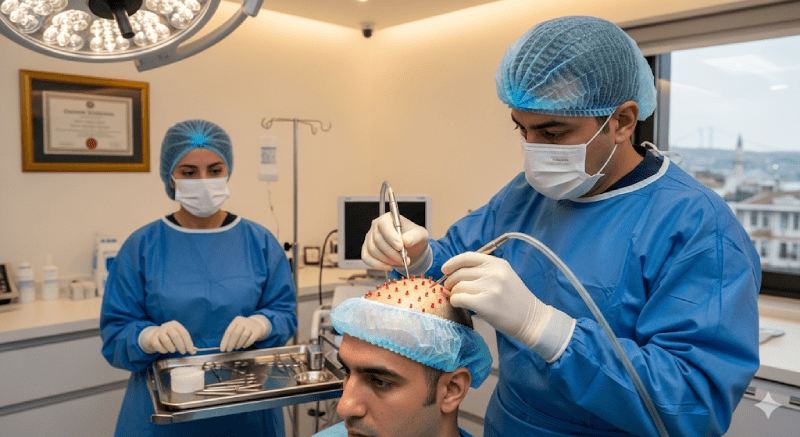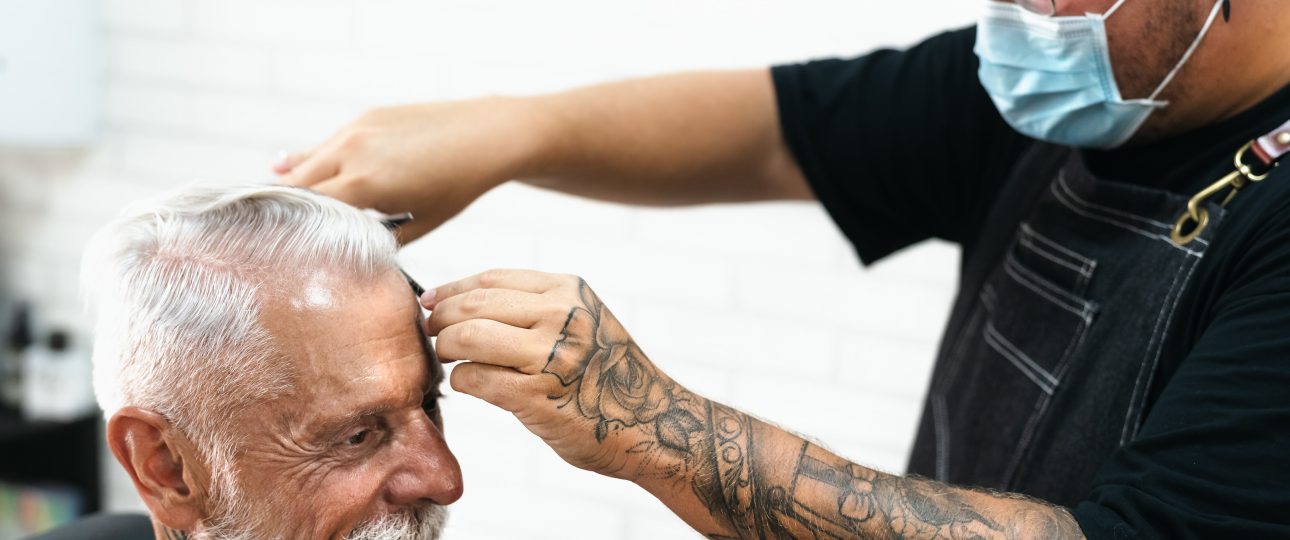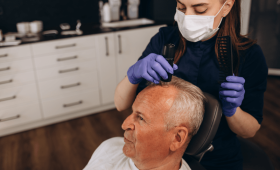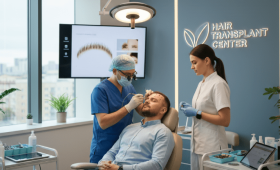What is Hair Transplantation?
Hair transplantation is the process of transferring hair follicles that are genetically resistant to shedding, usually from the back of the head, to areas experiencing baldness or thinning. This procedure aims to restore hair to hairless areas and allow the person to have natural, lush hair. Hair transplantation offers a permanent and aesthetic solution for men and women experiencing hair loss. Today, the most commonly used techniques are minimally invasive methods such as FUE and DHI.
Who is a Suitable Candidate for Hair Transplantation?
Suitable candidates for hair transplantation are primarily individuals who have a sufficient amount of healthy donor hair follicles. The back of the head (nape area) is generally used as the donor area. The main candidates are men with genetic hair loss and women with hair thinning. In addition, they must be in good general health and not have a chronic disease (such as uncontrolled diabetes, bleeding disorders). Being over the age of 18 is also a criterion as it is a surgical procedure.
What Hair Transplantation Methods are Available?
The most commonly used hair transplantation methods today are FUE (Follicular Unit Extraction) and DHI (Direct Hair Implantation). In the FUE method, hair follicles are harvested one by one from the donor area and transplanted into channels opened in the hairless area.
In the DHI method, hair follicles are placed directly into the transplantation area using a special pen (Choi implanter pen). Both methods have their own advantages and disadvantages. Which method is most suitable is determined according to the patient’s hair structure and needs.
Is Hair Transplantation a Painful Procedure?
The hair transplantation procedure is generally performed under local anesthesia, so the patient does not feel any pain. A slight stinging sensation may be felt during the anesthesia injections, but this feeling is short-lived. The patient remains awake during the procedure and can comfortably listen to music or watch a movie. In the post-operative period, there may be a slight tenderness and soreness, but this condition is easily controlled with painkillers prescribed by the doctor.
How Long Does the Hair Transplantation Procedure Take?
The duration of the hair transplantation procedure varies depending on the number of hair follicles to be transplanted and the technique used. An average session lasts between 4 and 8 hours. This time also includes lunch and small breaks. If a high number of grafts, such as 4000-5000, are to be transplanted, the duration may be longer. The duration of the procedure also varies depending on the experience of the surgical team and the condition of the patient’s donor area.
How Does the Healing Process Work?
The healing process after a hair transplant is generally quite fast. In the first few days, crusting, redness, and swelling may be seen in both the donor area and the transplanted area. These symptoms begin to decrease within a week. It takes about 10 days for the transplanted hair follicles to take hold in their new places. Full recovery and the shedding of the scabs are completed in an average of 10-14 days. During this process, it is vital to meticulously follow the doctor’s instructions for the success of the result.
When Do the Results Become Visible?
The full emergence of hair transplant results requires a process. About 80% of the transplanted hairs enter a phase called shock shedding within the first 2-4 weeks and fall out. This is a normal situation and should not cause concern. The transplanted hairs start to grow again after 3-4 months. While a large portion of the hair has grown by the end of 6 months, it is necessary to wait for 12-18 months for the final and complete result.
Is Hair Transplantation a Permanent Solution?
Yes, hair transplantation is a permanent solution. The reason for this is that the hair follicles used for transplantation are genetically resistant to shedding. These follicles are usually taken from the back of the head, and the hair there does not fall out for life. When they are transplanted to their new places, they retain this characteristic and do not fall out. Therefore, the results obtained with the hair transplantation procedure are permanent for life and are in harmony with the person’s natural hair.
Do Scars Remain After Hair Transplantation?
Minimal scarring may remain depending on the hair transplantation method. In modern techniques such as FUE and DHI, a strip-shaped scar does not form because the hair follicles are harvested one by one. In the donor area, microscopic dot-like scars remain where the hair follicles were taken, but these scars are almost invisible even with short hair. With the right technique and an experienced surgeon, the scars are minimized.
What are the Side Effects After Hair Transplantation?
The side effects that may be seen after a hair transplant are generally mild and temporary. The most common side effects include swelling, redness, itching, and mild pain in the operation area. In addition, there may be some numbness in the donor area. These side effects usually disappear on their own within a few days. The risk of infection is very low, but it can occur if hygiene rules are not followed.

What Should Be Considered Before the Operation?
There are a few important points to consider before a hair transplant operation. It is necessary to stop blood thinners, alcohol, and cigarettes at least one week before the procedure. Smoking narrows the blood vessels, reducing blood flow and can negatively affect the healing process. On the day of the operation, you should wear comfortable clothes, have breakfast, and avoid caffeinated beverages. These simple precautions increase the success of the surgery.
What Should Be Considered After the Operation?
The first few days after a hair transplant are very important. The donor and transplanted areas should not be exposed to water in the first 24 hours after the operation. You should lie with your head elevated and avoid sudden movements. The medications recommended by the doctor should be used regularly, and the first washing should be done professionally. Hygiene rules must be strictly followed to reduce the risk of infection. For the first 10-14 days, the transplanted area should be avoided until the scabs fall off.
Can Women Have Hair Transplantation?
Yes, women can also have hair transplants. Hair transplantation can offer a successful solution for women experiencing female-pattern hair loss or severe hair thinning. In women, hair transplantation is usually done by transplanting hair follicles taken from the donor area between the existing hairs, and this procedure can also be performed without shaving. This allows women to return to their daily lives more quickly.
What Factors Affect Hair Transplant Prices?
Hair transplant prices vary depending on many factors. The most important factors include the number of grafts to be transplanted, the technique to be used (FUE or DHI), the experience of the clinic and the surgeon performing the operation, the location of the clinic, and the additional services offered. Therefore, the most accurate approach to get a clear price is to have a preliminary examination and create a personalized treatment plan.
Is Shaving-Free Hair Transplantation Possible?
Yes, shaving-free hair transplantation is a possible option. In this method, which is usually applied with the DHI technique, the hair in the donor area is shaved in small windows and camouflaged between the hairs. In this way, the overall hair appearance is preserved, and it is not very obvious that the operation has been performed. Shaving-free transplantation is preferred especially by individuals with long hair and women. This method is more suitable for cases where the number of grafts to be transplanted is limited.
Can Beard or Body Hair Be Used?
Yes, in cases where the donor area is insufficient, beard or body hair can also be used for hair transplantation. Generally, chest hair or beard hair is used as a supplement when the donor area is not sufficient. Since beard hair has a thicker structure, it can provide a fuller appearance on the scalp. However, the growth cycles and structures of beard and body hair are different from those of scalp hair. This method is an option for patients who need additional hair follicles.
What is Shock Shedding?
Shock shedding is the temporary shedding of many of the transplanted hair follicles after the hair transplantation procedure. This is a resting phase that the hair follicles enter to adapt to their new location. It starts within 2 to 4 weeks after the operation and lasts for about a few weeks. Shock shedding is a natural part of a successful hair transplant and is not a cause for concern. New and permanent hairs will grow in place of the shed hairs.
When Can I Return to Work?
The time to return to work after a hair transplant depends on the type of work. For those who work in an office environment, it is generally possible to return to work after 1-2 days. However, it should be kept in mind that the head may be swollen and there will be scabs for the first few days. This period may be longer for those who work in a physically demanding job or in difficult conditions. It is important to follow the doctor’s recommended period to not interrupt the healing process.
When Can I Start Exercising?
The time to start exercising after a hair transplant is limited to the first 2 weeks after the operation. In the first week, only activities like light walking can be done. To prevent the hair follicles from moving, heavy exercises, activities that cause sweating, and sports that may cause an impact should be avoided for at least one month. Especially for swimming in a pool or the sea, it is necessary to wait for 1 month.

Is a Second Hair Transplant Possible?
Yes, a second hair transplant procedure is possible. If the patient’s donor area has enough hair follicles, a second operation can be planned after 1 year has passed since the first transplant. This procedure is usually done to fill in the gaps left after the first transplant or to achieve an even denser appearance.
How Should a Clinic/Surgeon Be Chosen?
Choosing a clinic and a surgeon is the most critical step for the success of a hair transplant operation. Before making a decision, it is important to examine the clinic’s and the surgeon’s experience, references, and patient reviews in detail. The clinic must provide services in a hygienic and modern environment, the operation must be performed by an expert team, and pre-operative and post-operative follow-up must be done meticulously.
Is Hair Transplantation a Safe Procedure?
Hair transplantation is a very safe procedure when performed under the right conditions and by an experienced surgeon. Since it is a procedure performed under local anesthesia, it does not carry the risks of general anesthesia. The risk of a serious side effect or complication is very low. However, when done in unsterile environments or by inexperienced people, risks such as infection and poor results can increase.
How Long Do the Transplanted Hairs Last?
The transplanted hairs are permanent for life because they are naturally resistant to shedding. These follicles, taken from the back and sides of the head, are immune to the genetic factors that cause shedding. These follicles also retain this characteristic in their new places. Therefore, the hairs obtained with a successful hair transplant do not fall out except for shedding due to the natural aging process.
When and How Should the Hair Be Washed?
The first wash after a hair transplant is usually done by the clinic 2 or 3 days after the operation. The first wash is performed with special shampoos and lotions and with very gentle movements to protect the sensitive transplanted area. In the following days, the patient should wash their hair as instructed by the doctor. Until the scabs have completely fallen off, pressurized water should not be used on the transplanted area, and it should not be rubbed hard.
Can a Hat Be Worn After Hair Transplantation?
Wearing a hat is not recommended for the first few days after a hair transplant because the transplanted area is sensitive. It is generally allowed to wear a hat 10-14 days after the operation, i.e., after the scabs have completely fallen off. During this period, it is important to protect the transplanted area from the sun and external factors. The hat should be loose and made of soft fabric that does not put pressure on the transplanted area.
What is the FUE Method?
The FUE (Follicular Unit Extraction) method is the process of harvesting hair follicles one by one from the donor area using a special micro motor or manual tools. This method uses a very small needle tip to harvest a single hair follicle (graft). The harvested grafts are then placed into channels pre-opened in the transplantation area. This method is one of the most popular and modern hair transplantation techniques as it does not leave a strip-shaped scar.
What is the DHI Method?
The DHI (Direct Hair Implantation) method, unlike FUE, is the harvesting and transplantation of hair follicles in a single step using a special pen (Choi implanter pen). The tip of this pen is thin and sharp, and it performs both channel opening and hair follicle placement at the same time. This method is less traumatic and provides a faster recovery because there is no need to open channels in the hairless area.
Which Method is Better?
Which method is better depends on the patient’s individual needs and hair structure. FUE offers the opportunity to transplant more grafts faster in large areas, while DHI provides more precise transplantation and hair density. Both methods have their own advantages. To determine the most suitable method, a detailed analysis of the hair structure and expectations should be done by consulting with a specialist.
Can Transplanted Hairs Be Dyed or Cut?
Yes, transplanted hairs grow, can be cut, and can be dyed just like your other natural hairs. However, for dyeing and other chemical procedures, the healing process must be completed, and the transplanted area must be completely recovered. Generally, hair dyeing can be done within 6-8 months after the hair transplant. For cutting the hair, it is enough to wait for 1 month after the operation.
Is There Pain or Swelling After Hair Transplantation?
Pain and swelling after a hair transplant procedure are normal. Due to the sensitivity of the hair follicles taken from the nape area and the transplanted area, there may be mild pain and swelling. This condition is controlled by lying with the head elevated and using painkillers recommended by the doctor. Generally, swelling reaches its peak in the first few days and begins to decrease within a week.
In Which Countries Can I Get Cheap Hair Transplant?
There are many countries where cheap hair transplantation can be obtained. However, getting a hair transplant is an important procedure. It is normal for you to look for a country to get a hair transplant at more affordable prices, instead of paying thousands of euros to get a hair transplant. However, while buying affordable hair transplantation, you should also pay attention to its quality.
You can get a very affordable hair transplant in countries such as India, Lithuania, Poland,Mexico, Bulgaria, Costa Rica, Thailand. However, there is no case that proves that the hair transplants given by these countries are of high quality. It is important that the country where you receive the hair transplant is of good quality, that the treatment is not shedding and that there is no risk of infection.
Is It Risky To Get Cheap Hair Transplant?
It cannot always be said that yes is risky, nor can it be said that no is risk-free. However, the above-mentioned countries do hair transplantation very cheaply, some of them provide treatment at higher prices than Turkey. There are many patients who have been treated in most of the countries listed above, but who experience hair loss in the treated areas and come to Turkey for new treatments.
In addition, the number of patients who have an infection after the treatment and wait for a long time for the infection to heal for a new treatment is quite high. Therefore, regardless of your country preference, a detailed research on the clinic is required. If you prefer a poor quality country to have a cheap hair transplant, it is inevitable that more money will come out of your pocket.
Mexico, India, Thailand Bulgaria And Poland Successful In Hair Transplantation?
These countries, provide hair treatments at very affordable prices. However, they do not have any descriptions showing that they are of good quality. Of course, not every clinic is bad in these countries. Of course, there are a few clinics that do good hair transplants.
However, it can be difficult to find these clinics in an unfamiliar country. For this reason, you should do a detailed and devoted research, find previous hair transplant treatments and learn about patient experiences. It will be more advantageous for you to choose a country that is known by everyone and specializes in hair transplantation, instead of dealing with all these and wasting time.
What is the Secret of Turkey’s Success in Hair Transplantation?
Turkey continues to be the number one country in hair transplantation for many years. In fact, it is one of the countries in the first place in the sentences searched as “Hair Transplantation” in many countries.
The reason Turkey is so successful is that its treatments are of high quality and affordable. All devices used in hair transplant clinics in Turkey are very sterile. And almost all of them are state-of-the-art gadgets. The products and devices used in each step applied during the treatment are sterilized. Thus, any risk of infection in the treatment area applied to the patient is prevented and the success rate of the treatment is increased. Remember, the better the quality of treatment you receive, the more successful the treatment will be.
Can I Get Successful Treatment In Every Clinic In Turkey?
Unfortunately, this is not possible in Turkey as it is not in any other country. However, it is of course higher than in other countries. This is because there are many branded clinics. If you also want to have a hair transplant in Turkey, but have not chosen a clinic yet, you can contact us to receive treatment in branded, first-class clinics.
Considerations When Choosing A Clinic In Turkey
- You can see previous hair transplant treatments from the clinic’s social media accounts.
- You can read the objective experiences of the patients on the websites of the clinic. So it will be easy for you to understand whether they are giving good treatment or not.
- You can ask the clinic whether they have a health tourism authorization certificate. Thus, you can receive treatment in the cliques that are inspected by the Turkish state every 6 months. This shows that it gives better quality and successful treatments.
Hair Transplant Costs Abroad
While there are countries with cheap prices abroad, there are also countries that offer very high-priced treatments. You can find the cheapest treatments abroad, treatments for 1500 euros in countries such as Mexico, India, Poland and Hungary, as well as treatments up to 15000 euros in countries such as America, Canada, Germany, the United Kingdom.
Some clinics offer excellent treatments, while others offer very poor treatments. The important thing here is how you should choose the clinic. Therefore, there are some tips.
Hair Transplant Cost In Turkey 2025
As Cure Holiday, offer hair transplantation treatment for 1300 euros, as we aim to return the patients to their countries satisfied. At the same time, we offer package prices to 1650 euros for patients who want accommodation and transfer. Accommodation in a first class hotel for 2 days and all transfers are included in the package price.
What Are The Advantages Of Hair Transplantation With Cure Holiday?
- Cure Holiday works with the best quality clinics in Turkey. According to the location preferred by the patient, it lists the best clinics and creates reservations based on patient selection.
- CureHoliday transfers patients to many clinics. For this reason, it has agreements with clinics and offers treatment services at prices below the market.
- The problems you experience during the treatments you receive with CureHoliday allow you to be re-examined and treated free of charge.
- Cure Holiday works with clinics that have a health tourism authorization certificate.
No commission or additional fee is charged from the patients. The Republic of Turkey pays a commission per patient because we provide foreign currency inflows.
This payment is made by the Turkish state. It does not reflect on you in any way. On the contrary, since we provide too many patient admissions to the Clinics, we enable our patients to pay lower than normal prices with extra discounts.



